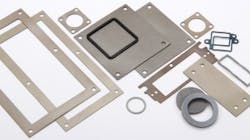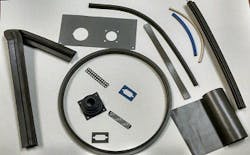Particle-filled silicones provide EMI shielding and environmental sealing
Particle-filled silicones are elastomeric compounds that combine the advantages of silicone with the electrical properties of metals. An inert, synthetic rubber, silicone offers thermal stability over a wide temperature range and resists ozone and ultraviolet (UV) light. Silicone rubber also resists water, and can be formulated to impart electrical conductivity. When filled with tiny metal particles, typically silver-plated or nickel-coated, silicone compounds can be used for environmental seals that resist electromagnetic interference (EMI).
EMI shielding isn’t new, of course, but some fabricators have concerns about particle-filled silicones. Silicones have desirable material properties, but loading a high percentage of particle filler into the rubber in an effort to increase conductivity can result in negative tradeoffs. Typically, industry professionals worry that particle filled electrically-conductive silicones are:
- too hard,
- too brittle,
- too expensive,
- have long lead times,
- limited by mold size dimensions, and
- not thin enough for newer, thinner designs.
Solving sealing and insulation challenges
Today, a variety of industries are using particle-filled conductive silicones for EMI shielding and environmental sealing. Military electronics, medical, automotive, and other markets are demanding, but so are the safety requirements for the kiosks in factories and various public venues. Are metal-filled elastomers right for these and other applications? Is it possible to source particle-filled silicones that aren’t too hard, too brittle, too expensive, take too long to produce, or are too thick?
For fabricators, die cutters, and molders, it’s important to understand that there are next-generation materials that address these concerns. It’s also essential to have the technical knowledge to answer questions about these materials.
Today, conductive silicone elastomers are designed specifically to overcome the most common material challenges. Designed to balance cost competitiveness with electrical conductivity, these particle-filled products include uncured moldable compounds, compression molded sheet stock, and continuous rolls all ready to be custom-converted by the individual fabricator.
By understanding the characteristics of these metal-filled silicones, gasket fabricators can suggest reliable, cost-effective compounds for sealing and insulation. Then, using whatever conversion method is most efficient, fabricators can supply EMI/RFI (radio-frequency interference) gaskets that meet demanding application requirements. Some industry professionals need convincing, however, so let’s examine some common objections to using particle-filled silicones for shielding and sealing. Along the way, we’ll look at how next-generation materials overcome these challenges.
Material hardness
Conductive silicones don’t have to be “too hard.” For good reason, seal designers worry that a gasket made from a hard rubber will make an enclosure difficult to close, or allow the ingress of contaminants, chemicals, or water. Softer seal materials can improve compression, but it’s still essential to avoid metal-on-metal contact.
Tensile strength and tear strength
In addition to concerns about material hardness, some gasket fabricators believe that particle-filled silicones are too brittle and will tear easily. When a material lacks sufficient tensile strength, cutting a small part with a thin cross-section may result in tearing during packaging or application. With more expensive compounds, there are also concerns about the high cost of material waste. Even worse, a tear during product application can cause the loss of a conductive seal and allow the entry of radio-frequency (RF) waves.
To solve these problems, SSP has the capability to reinforce its EMI/RFI silicones with an inner layer of conductive fabric that enhances material strength while ensuring conductivity. Whereas other highly-filled compounds have an insufficient tear strength, SSP’s nickel-coated graphite-filled silicones enable thinner, smaller, and lighter weight EMI/RFI solutions. (For example, SSP502-65-032-Composite-NG is a nickel-coated, graphite-filled elastomer with a tensile strength of 950 psi and a Tear “B” ppi of 165.)
Cost and performance
Gasket fabricators, die cutters, and molders are concerned about more than just the material properties of particle-filled conductive silicones. Cost is an important consideration, especially in commercial applications. Compounds that use silver-coated particles provide excellent shielding effectiveness, but silver is subject to volatility in the precious metals market. If the price of silver rises dramatically, an EMI/RFI shielding gasket that costs $15 today could cost several times that amount next year. For fabricators and their customers who need to manage costs, such uncertainty is undesirable.
Size dimensions and lead times
Fabricators understand the importance of size dimensions, especially with regard to production times and cost. For example, compression molded sheets can take a long time to produce. Sheets with different thicknesses require different tooling, which also adds to costs. To produce sheets that are longer than the standard 15” to 20” mold size, bonding or joining are necessary. When evaluating particle-filled conductive silicones then, gasket fabricators may choose continuous rolls instead of compression molded sheet stock.
Fabricators should consider the roll’s thickness and width, however, and also ask themselves an important question: how can we supply the greatest number of high-quality gaskets with the least amount of waste?
Material thickness
Some fabricators believe that all particle-filled conductive silicones are too thick, especially because so many consumer products now feature thinner profiles. Today, “smart technologies” such as cell phones, computer monitors, and interfaces feature slim and attractive screens with EMI/RFI shielding. The same is true of kiosks at amusement parks and shopping malls, where cell phone traffic can interfere with electronic displays. Factory kiosks also emit RF waves, and production workers require protection from daily exposure.
Conclusion
Gasket fabricators need to know that it’s possible to source specialty silicones that aren’t too hard, too brittle, too expensive, take too long to produce, or are too thick. In addition to aerospace, medical, military, automotive and consumer electronics, applications for these metal-filled elastomers include unmanned aerial vehicles (UAVs), shielded rooms and enclosures, and heavy equipment with global positioning systems (GPS). Now that you know more about the characteristics of particle-filled silicones, feel free to educate your contacts and partners in these industries.
SSP solutions
Specialty Silicone Products Inc. (SSP) supplies a line of conductive silicone elastomers that are designed specifically to overcome the most common material challenges. Designed to balance cost competitiveness with electrical conductivity, these particle-filled products include uncured moldable compounds, compression molded sheet stock, and continuous rolls all ready to be custom-converted by the individual fabricator.
To address customer requests and industry complaints about metal-filled elastomers, SSP has developed ultra-soft silicones as low as 30 Shore A. These specialty silicones are available with silver-coated or nickel-coated particles, and combine EMI shielding with environmental sealing. For example, SSP2426-30 is a 30-durometer silicone compound that’s filed with silver-plated aluminum particles. SSP502-30 is a 30-durometer nickel-coated, graphite-filled silicone elastomer. Both particle-filled silicones are supplied as fully cured, conductive sheet stock; continuous extrusion profiles; and ready-to-mold compounds.
SSP produces both sheets and rolls at its Ballston Spa, NY facility, but continuous rolls offer several advantages. First, since these rolls are produced and cured continuously, SSP can manufacture 1000 ft. per day, the equivalent of 600 standard 15x20-inch sheets, with short lead times.
To meet the thickness requirements of these and other applications, SSP supplies conductive silicones as thin as .009 inch. By contrast, other suppliers offer compounds that are, at a minimum, between .015-inch and .020-inch thick.
At the same time, and as this technical article explains, SSP’s metal-filled elastomers are softer, less brittle, and more resistant to tearing than other particle-filled silicones. SSP’s nickel-coated graphite silicones offer the performance levels of silver-coated products, and the availability of continuous rolls means that fabricators can order and receive the quantities they need.
To address concerns about cost, SSP supplies superior nickel-coated graphite silicones that have the performance levels of silver-coated products. For example, the minimum shielding levels accepted by MIL-DTL-83528C is 100 dB from 20 MHz through 10 GHz. The high-performance nickel-coated graphite formulations average 115 dB from 20 MHz through 10 GHz.
(All third-party testing results are available upon request, including data on corrosion and salt spray. Contact [email protected], call (518) 885-8826, or visit http://www.sspinc.com for more information.)
About the Author
Dominic Testo is an executive at Specialty Silicone Products (SSP) Inc. in Ballston Spa, N.Y.
SSP was founded in 1988 when five colleagues working for GE Silicones identified several unmet markets within the silicone industry. The humble beginnings took place in an Industrial Park where they combined their experience to manufacture and supply Septa products to the pharmaceutical industry, conductive silicones to the Electronics and Military markets, and custom compounds for a variety of Industrial molding applications. The Managing Partners developed a reputation for quality and fast service.
As the company's reputation for flexibility expanded it recruited talented employees that could broaden its' product portfolio and extend its market reach. The continued success caused the company to outgrow its headquarters in 2001. Within a few miles of its original location, the company established a Technology Park where it constructed a 35,000 square-foot plant and office space.


